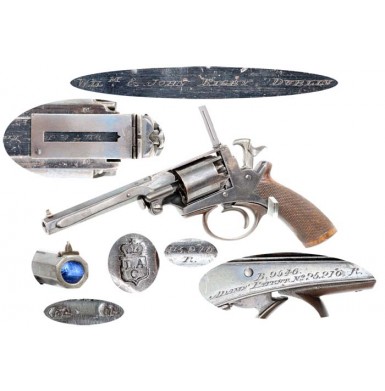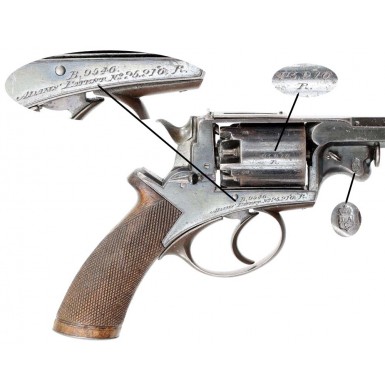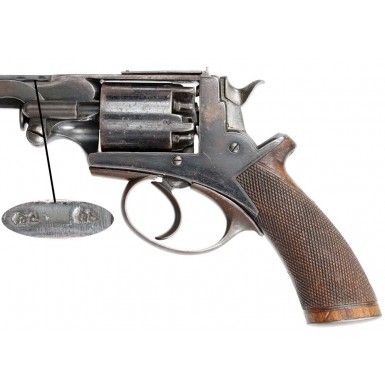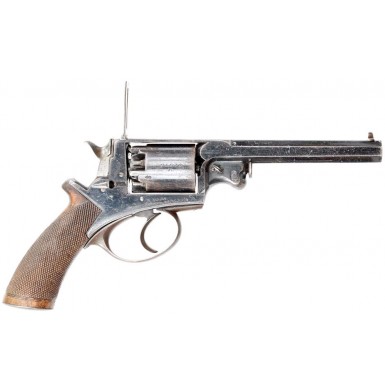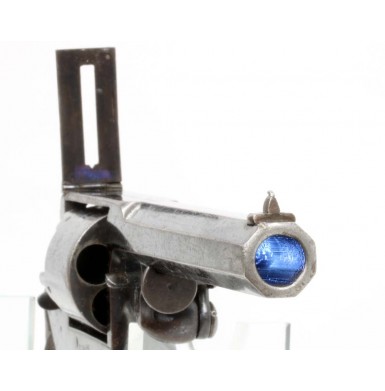Adams Patent Revolver - Rigby Retailer Marked
- Product Code: FHG-1792-SOLD
- Availability: Out Of Stock
-
$1.00
This is a very attractive example of the Beaumont-Adams M-1854 double action revolver with a unique and unusual long range rear sight. These fine quality, solid frame, revolvers were as important to the history and development of the revolving handgun as were the developments and designs of Samuel Colt. Robert Adams received his patent for a solid frame, one-piece revolver design in 1851. The patent covered his design for a very strong revolver, where the frame and barrel were machined from a single forging. Adams additionally patented a self-cocking lockwork, which today would be referred to as “double action only”. This mechanism cocked the spurless hammer, rotated the cylinder and released the hammer, all as the result of a single pull of the trigger. While this allowed for rapid firing of the gun, the long, heavy trigger pull inhibited accuracy. The solid frame & barrel and the “self-cocking” lockwork were incorporated into Adams’ Model 1851 series of revolvers. In 1854 Lt. Frederick Beaumont developed an improvement for Adams’ lockwork, which produced what would be called a traditional “double action” revolver today. The new lockwork allowed the revolver to operate in the fashion of Adams’ original design, but also added the facility to cock the revolver manually and fire it with a lighter “single action” trigger pull. In order to thumb cock the action, a spur was added to Adams’ previously spurless hammer. This refinement allowed for more accurate shooting. In 1854 Adams also patented refinements to his original frame design by adding a sliding frame mounted safety on the right side of the revolver, and an improved cylinder arbor retaining mechanism as well. The resultant combination of design improvements was manufactured as the M-1854 revolver, known to most as the Beaumont-Adams revolver. The new revolvers were produced directly by Adams as part of his partnership with the London based Deane, Adams & Deane, as well under license by Birmingham makers like Joseph Brazier and Isaac Hollis & Sons. The revolver was also licensed for production in America (by the Massachusetts Arms Company), as well as in Belgium, and some of the German states. William Tranter also produced Adams solid frame under license, providing them to Adams for use in Adams revolver production and using them in the production of his own line of self-cocking revolvers. Upon the dissolution of the Deane, Adams & Deane firm, Adams went to work for the London Armoury Company, and his revolvers were produced there as well from 1857-1859.
It is difficult to ascertain exactly how many Adams patent revolvers were imported for use during the American Civil War. At least 1,075 were purchased directly by the US government. It is known that some military outfitters like Schuyler, Hartley & Graham purchased quantities of these revolvers for private sale to officers and those volunteer groups who looked to their state and local government (rather than the US government) to purchase arms. Some of the Schuyler, Hartley & Graham guns (about 300) are reported to have been purchased by the state of Alabama prior to the war. Virginia and Georgia are reported to have made pre-war purchases of these revolvers as well. While the Confederate central government never directly contracted to purchase Adams patent revolvers (they concentrated on purchasing Kerr’s Patent revolvers from the London Armoury Company), Confederate speculators and individual states did purchase these fine English revolvers in some quantity. A number of Confederate identified and presented Adams revolvers exist in public and private collections, including #40537 in the Museum of the Confederacy. This revolver is cased with an engraved presentation plaque from Robert Adams to Confederate General Stonewall Jackson. Two other Adams revolvers in the low 41,XXX range are attributed to Confederate naval use aboard the CSS Shenandoah. Most Confederate war time purchases are believed to fall roughly within the 33,000 to 42,000 serial number range, although it is quite likely that guns produced prior to that range (and imported to America) were used, and in some cases old stock was sold to Confederate speculators, resulting in pistols that were several years old passing through the blockade. Civil War regiments that are known to have carried or been issued Adams Patent revolvers include the 8th PA and 2nd MI cavalry on the US side and the 1st & 5th VA and 5th GA cavalry on the CS side. It is generally assumed that the majority of these guns were 54-bore (.442 caliber) Beaumont Adams M-1854 pattern revolvers.
This M-1854 Beaumont Adams Revolver is in about VERY FINE condition. The gun is a 54 bore (.442 caliber) revolver with a 5-shot cylinder with the serial number 25,216 R engraved on both the frame and cylinder. The gun is of particular interest to collectors as it is one of the revolvers produced by the London Armoury Company during Adams’ tenure there. The London Armoury logo of an (CROWN) / LA / C (within a shield) is clearly stamped on the obverse of the barrel lug, forward and below of the cylinder. While it is difficult to date Adams revolvers from their serial numbers the way you can with Colt revolvers, it is safe to assume that this revolver was probably produced in the years immediately leading up to the American Civil War, likely circa 1858-1859. The M-1854 frame improvements were not put into production until February of 1855, and London Armoury production started somewhere in the low 17,000 serial number range in late 1856 or early 1857, continuing through about 1859. The R-suffix to the serial number indicates manufacture by Adams, although in this case Adams was employed by the London Armoury Company. The gun also bears a B-prefix serial number, which was applied to the revolvers from the beginning of Beaumont-Adams production through sometime in 1862. These “B-numbers’ were patent royalty tracking numbers, in reference to Beaumont’s lockwork patent, and helped insure Beaumont was paid the appropriate patent royalties for the use of his design. On this revolver that number is B 9546. The top of the frame is crisply engraved:
WILM & JOHN RIGBY DUBLIN. The firm of John Rigby & Company was established in Dublin, Ireland in 1775. In 1816 the “second” John Rigby joined the firm and in 1818 the company was known as William & John Rigby, with that branch of the business remaining in Dublin until 1892. At that time Truelock & Harris acquired the Irish portion of the business, which subsequently closed its doors in 1897. In 1851 John Rigby III displayed much of his work at the Great Exhibition in London and in 1858 began collaborations with Joseph Needham in the design of self-contained cartridge firearms. It would be John Rigby III who would be responsible for the world-renowned fame of the Rigby name when associated with firearms. In 1866 John Rigby III established John Rigby & Company at 72 St. James Street in London, where the firm remained until 1907, at which time they relocated 43 Sackville street. In 1900 the firm was renamed John Rigby & Co LTD. During the early 1870s Rigby concentrated his design efforts on producing high quality match rifles, as well as working on designs to improve and enhance cartridge firearms, especially double rifles for big game hunting. In 1879 Rigby debuted his “Rising Bite” series of big game double guns that remain in production to this day. In fact, if you would like to order a Rigby Rising Bite (only available in .470 or .500 Nitro Express), be prepared to wait at least three years. You should also be prepared for the price, as the guns start at “95,000 (about $145,000) and go up from there. In 1887 Rigby was appointed the Superintendent of the Royal Small Arms Factory at Enfield Lock (RSAF), where he would continue to advance gun designs, and would collaborate with Paul Mauser in 1897 to develop the Mauser “Magnum” bolt action, which remains one of the strongest and most reliable actions for high powered cartridges to this day. Over the next decade Rigby would develop some of the most powerful big game cartridges ever produced, including the .450 Nitro Express (1898), the .350 No 2 and .350 Magnum (1908) and the world famous .416 Rigby (1911). John Rigby III died in 1916, but his name and the family business live on, with the company eventually bought by a series of investment groups that finally reunited the Rigby and Mauser names in 2103 after 100 years.
The obverse frame is engraved in two lines below the cylinder: B 12632 over ADAMS’ PATENT No 25,216 R. The cylinder bears the matching serial number 25,216 / R. The cylinder has the expected London commercial proof marks between the chambers and the barrel has a pair of London proofs on the upper left angled flat. The barrel is 5 ““ in length and is rifled with three wide grooves, roughly twice the width of the lands. The bore rates about FINE+ and is bright and shiny with only some very lightly scattered fine pitting and pinpricking along its length. As previously noted, the gun is in about VERY FINE overall condition, and retains much of its original finish. The barrel retains about 75%+ of the original bright polished blue, and the frame retains about 65%+ of its original finish. The cylinder retains about 65%+of its original blued finish as well. Some of the finish loss is the result of numerous minor surface scuffs and scratches that cover much of the gun, likely from handling, use and carry. Most of the areas where the finish has worn or faded have developed a mostly smooth plum-brown patina, with traces of pewter gray. There are also some scattered patches of minor surface oxidation and freckled browning present along some of the contact edges of the action, especially around the front and rear of the cylinder. The barrel and frame are mostly smooth and essentially free of any pitting, with only some very small, scattered patches of lightly oxidized surface peppering and pinpricking present, mostly in the areas mentioned above where the flash of the caustic percussion caps and hot gases from the cylinder gap have caused some minor surface erosion. The cylinder shows light to moderate pinpricking scattered over most of its recessed surfaces at the rear, with light pitting and oxidation present in the percussion cone (nipple) recesses. All of the original cones are all present and in very good, usable condition with no severe wear or battering. The gun retains its original Kerr’s patent loading lever. The lever is unmarked on the obverse and bears only the assembly number 12872 on its reverse. This same assembly number is present inside the triggerguard and on the rear face of the cylinder. The lever retains about 50%+ of its original blued finish as well. The lever is fully functional, operating smoothly and locking securely into place when not in use. The action of the revolver works perfectly in both single and double action modes, and is mechanically excellent. The cylinder times, indexes and locks up exactly as it should in both modes of operation. The hammer is finished in the white and has a smoky grayish brown patina, with some flecks of light surface oxidation present. The iron trigger guard retains traces of its original blue, which has faded and dulled, the result of handling and use, mixed with a dull steel gray patina. The iron butt cap retains no original blue, but has a smoky brownish-gray patina speckled with brown surface oxidation. The original M-1854 patent sliding safety is present on the right side of the frame and functions exactly as it should. It retains much of its original brilliant bluish-purple fire blued finish. The original M-1854 cylinder arbor retaining wing nut is in place on the right side of the frame and functions correctly as well. This delicate piece is often broken or missing, so it is nice to find it in complete, functional condition. The revolver has a unique long range, folding ladder rear sight mounted on the topstrap at the rear of the frame. The sight is not graduated and no elevating slider is present. I can only assume that Rigby expected the owner to regulate the sight based upon the loads used with it. I am only aware of one other example of a long-range sighted Adams like this, and it is in the collection of a renowned British arms historian, researcher and author. The checkered one-piece walnut grip is in FINE condition as well, showing only the usual expected light wear, with some very minor flattening to the tips of the checkering. The grip also shows some very light scattered handling dings and mars. The grip is solid with no chips, cracks or repairs noted. Overall, the condition of the revolver is indicative of a gun that was carried and that certainly saw some use, but was never abused during its service life and was always well cared for.
Overall this is a wonderful looking Beaumont-Adams patent revolver in a very nice state of preservation with a very scarce (possibly experimental) long range rear sight. The Adams revolvers were as important to the development of handguns England and on the European continent as the Colt revolvers were in America, and were some of the first truly successful double action style service revolvers to be produced in large quantities. These guns saw service on both sides during the American Civil War, and a Beaumont-Adams revolver is a must have in any Civil War revolver collection. This gun is in fine mechanical condition, retains a lot of finish and is very well marked. The desirable Rigby retailer mark makes the gun even more collectible. Given the condition and historic importance of these guns, it is bargain priced, when you consider that Colt M-1851 Navy in this condition would more than double the price of this revolver! Given the prices charged for Rigby arms that are newly made, this is a real steal!
SOLD
